CSIS 4720 Database Systems: Normalization, ERD, and MS Access Project
VerifiedAdded on 2022/09/18
|15
|1031
|28
Homework Assignment
AI Summary
This assignment focuses on database design and implementation, starting with a STUDENT table containing a repeating group. The student normalizes the table to 1NF, 2NF, and 3NF, identifying primary and foreign keys at each normal form level. An Entity Relationship Diagram (ERD) is created using Chen's notation. Subsequently, the assignment involves creating the table structures in SQL. Finally, the student implements the system using MS Access, including creating forms for data entry, writing SQL queries to retrieve specific data based on GPA, advisor, classification, and major, and generating reports to display the query results. A data dictionary is also included, detailing the attributes of each table, along with a bibliography of references used.
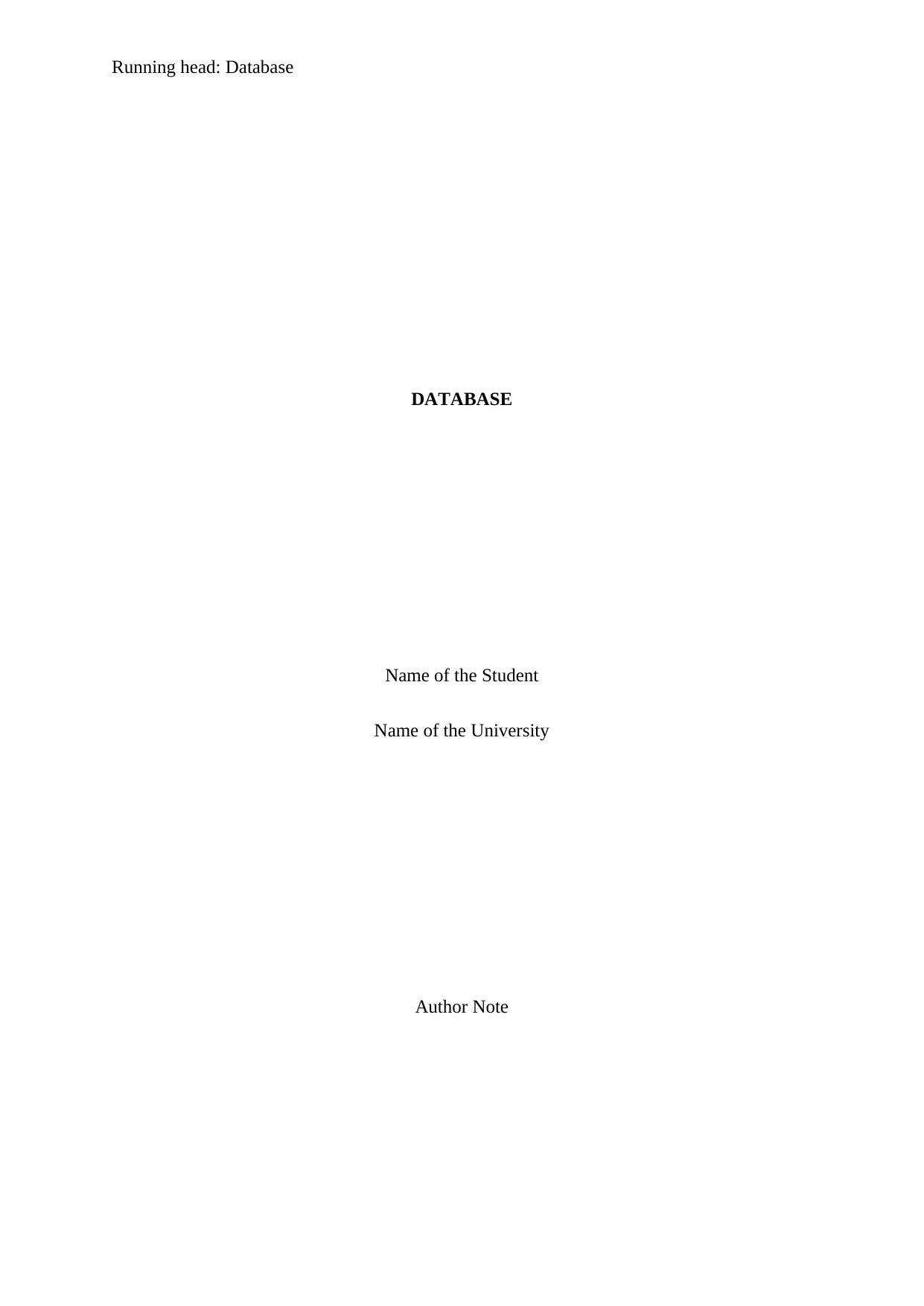
Running head: Database
DATABASE
Name of the Student
Name of the University
Author Note
DATABASE
Name of the Student
Name of the University
Author Note
Paraphrase This Document
Need a fresh take? Get an instant paraphrase of this document with our AI Paraphraser
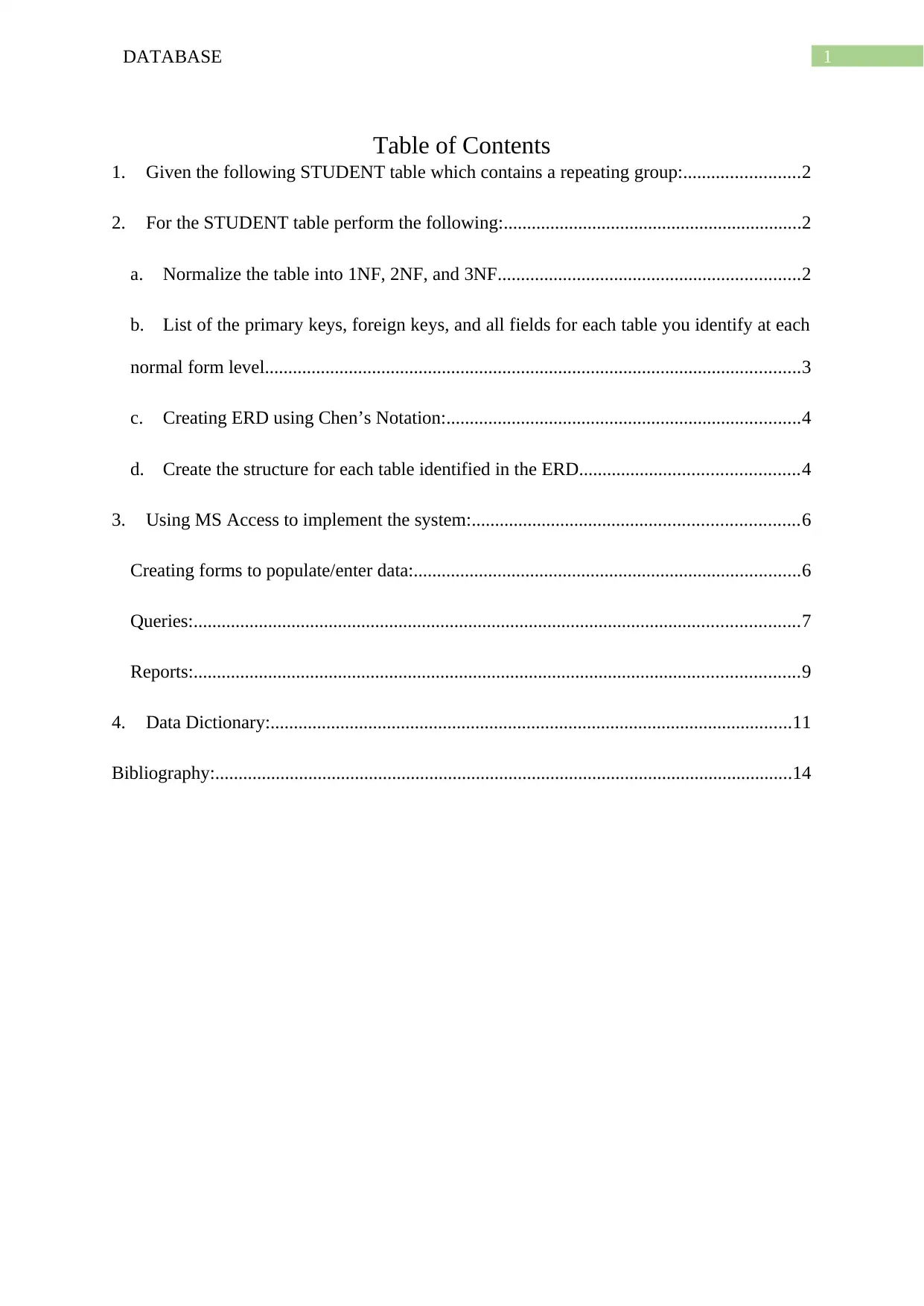
1DATABASE
Table of Contents
1. Given the following STUDENT table which contains a repeating group:.........................2
2. For the STUDENT table perform the following:................................................................2
a. Normalize the table into 1NF, 2NF, and 3NF.................................................................2
b. List of the primary keys, foreign keys, and all fields for each table you identify at each
normal form level...................................................................................................................3
c. Creating ERD using Chen’s Notation:............................................................................4
d. Create the structure for each table identified in the ERD...............................................4
3. Using MS Access to implement the system:......................................................................6
Creating forms to populate/enter data:...................................................................................6
Queries:..................................................................................................................................7
Reports:..................................................................................................................................9
4. Data Dictionary:................................................................................................................11
Bibliography:............................................................................................................................14
Table of Contents
1. Given the following STUDENT table which contains a repeating group:.........................2
2. For the STUDENT table perform the following:................................................................2
a. Normalize the table into 1NF, 2NF, and 3NF.................................................................2
b. List of the primary keys, foreign keys, and all fields for each table you identify at each
normal form level...................................................................................................................3
c. Creating ERD using Chen’s Notation:............................................................................4
d. Create the structure for each table identified in the ERD...............................................4
3. Using MS Access to implement the system:......................................................................6
Creating forms to populate/enter data:...................................................................................6
Queries:..................................................................................................................................7
Reports:..................................................................................................................................9
4. Data Dictionary:................................................................................................................11
Bibliography:............................................................................................................................14
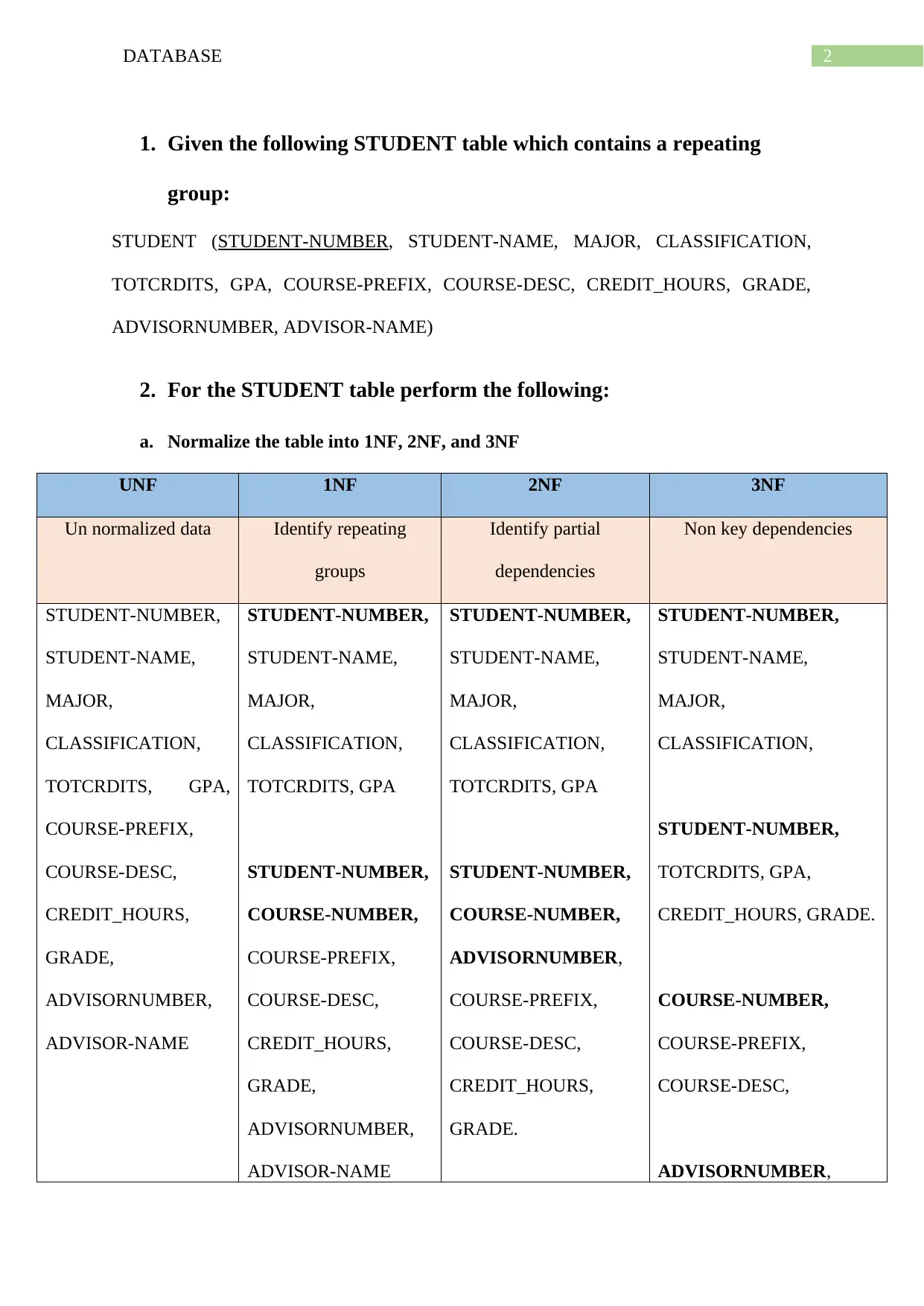
2DATABASE
1. Given the following STUDENT table which contains a repeating
group:
STUDENT (STUDENT-NUMBER, STUDENT-NAME, MAJOR, CLASSIFICATION,
TOTCRDITS, GPA, COURSE-PREFIX, COURSE-DESC, CREDIT_HOURS, GRADE,
ADVISORNUMBER, ADVISOR-NAME)
2. For the STUDENT table perform the following:
a. Normalize the table into 1NF, 2NF, and 3NF
UNF 1NF 2NF 3NF
Un normalized data Identify repeating
groups
Identify partial
dependencies
Non key dependencies
STUDENT-NUMBER,
STUDENT-NAME,
MAJOR,
CLASSIFICATION,
TOTCRDITS, GPA,
COURSE-PREFIX,
COURSE-DESC,
CREDIT_HOURS,
GRADE,
ADVISORNUMBER,
ADVISOR-NAME
STUDENT-NUMBER,
STUDENT-NAME,
MAJOR,
CLASSIFICATION,
TOTCRDITS, GPA
STUDENT-NUMBER,
COURSE-NUMBER,
COURSE-PREFIX,
COURSE-DESC,
CREDIT_HOURS,
GRADE,
ADVISORNUMBER,
ADVISOR-NAME
STUDENT-NUMBER,
STUDENT-NAME,
MAJOR,
CLASSIFICATION,
TOTCRDITS, GPA
STUDENT-NUMBER,
COURSE-NUMBER,
ADVISORNUMBER,
COURSE-PREFIX,
COURSE-DESC,
CREDIT_HOURS,
GRADE.
STUDENT-NUMBER,
STUDENT-NAME,
MAJOR,
CLASSIFICATION,
STUDENT-NUMBER,
TOTCRDITS, GPA,
CREDIT_HOURS, GRADE.
COURSE-NUMBER,
COURSE-PREFIX,
COURSE-DESC,
ADVISORNUMBER,
1. Given the following STUDENT table which contains a repeating
group:
STUDENT (STUDENT-NUMBER, STUDENT-NAME, MAJOR, CLASSIFICATION,
TOTCRDITS, GPA, COURSE-PREFIX, COURSE-DESC, CREDIT_HOURS, GRADE,
ADVISORNUMBER, ADVISOR-NAME)
2. For the STUDENT table perform the following:
a. Normalize the table into 1NF, 2NF, and 3NF
UNF 1NF 2NF 3NF
Un normalized data Identify repeating
groups
Identify partial
dependencies
Non key dependencies
STUDENT-NUMBER,
STUDENT-NAME,
MAJOR,
CLASSIFICATION,
TOTCRDITS, GPA,
COURSE-PREFIX,
COURSE-DESC,
CREDIT_HOURS,
GRADE,
ADVISORNUMBER,
ADVISOR-NAME
STUDENT-NUMBER,
STUDENT-NAME,
MAJOR,
CLASSIFICATION,
TOTCRDITS, GPA
STUDENT-NUMBER,
COURSE-NUMBER,
COURSE-PREFIX,
COURSE-DESC,
CREDIT_HOURS,
GRADE,
ADVISORNUMBER,
ADVISOR-NAME
STUDENT-NUMBER,
STUDENT-NAME,
MAJOR,
CLASSIFICATION,
TOTCRDITS, GPA
STUDENT-NUMBER,
COURSE-NUMBER,
ADVISORNUMBER,
COURSE-PREFIX,
COURSE-DESC,
CREDIT_HOURS,
GRADE.
STUDENT-NUMBER,
STUDENT-NAME,
MAJOR,
CLASSIFICATION,
STUDENT-NUMBER,
TOTCRDITS, GPA,
CREDIT_HOURS, GRADE.
COURSE-NUMBER,
COURSE-PREFIX,
COURSE-DESC,
ADVISORNUMBER,
⊘ This is a preview!⊘
Do you want full access?
Subscribe today to unlock all pages.

Trusted by 1+ million students worldwide
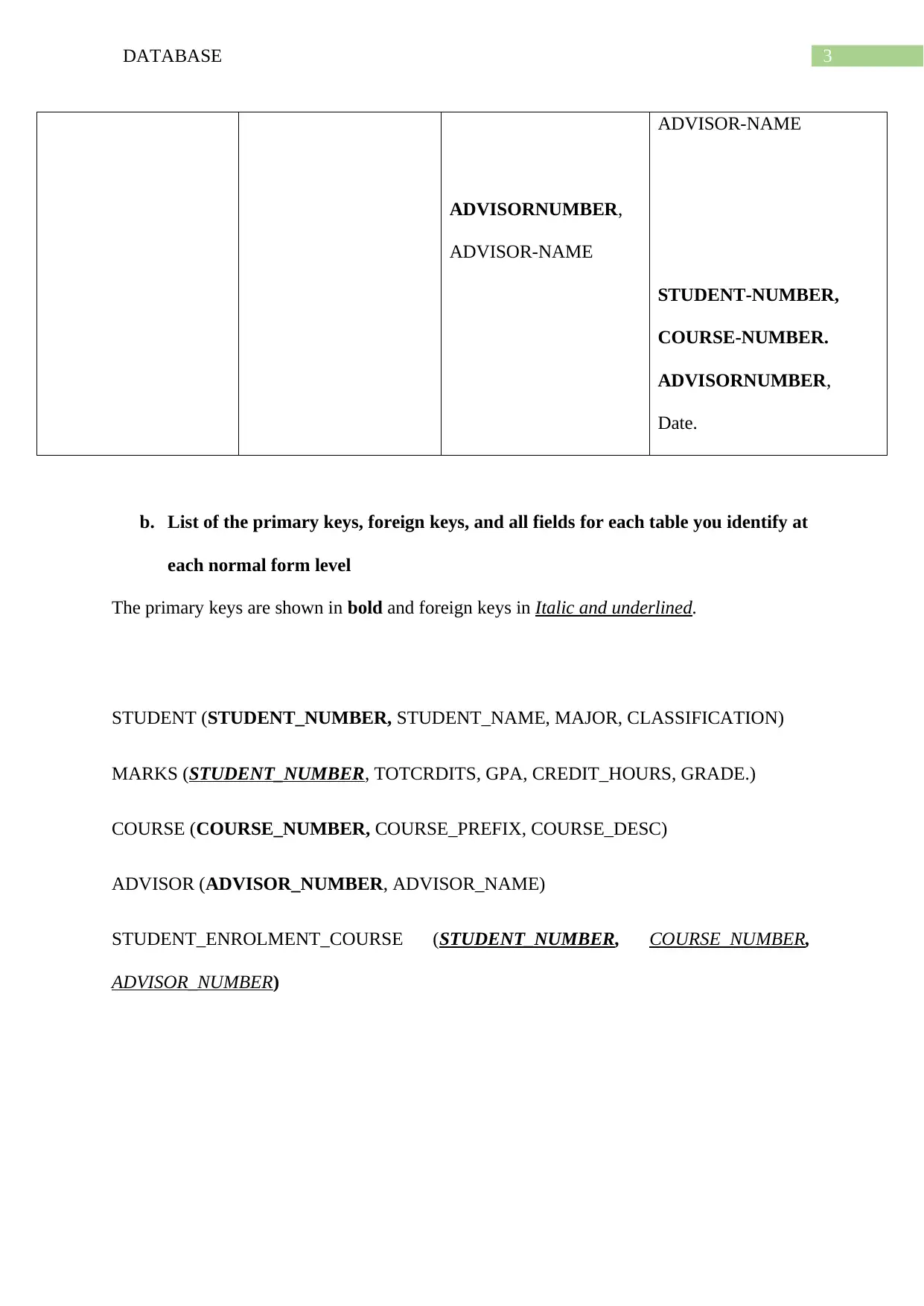
3DATABASE
ADVISORNUMBER,
ADVISOR-NAME
ADVISOR-NAME
STUDENT-NUMBER,
COURSE-NUMBER.
ADVISORNUMBER,
Date.
b. List of the primary keys, foreign keys, and all fields for each table you identify at
each normal form level
The primary keys are shown in bold and foreign keys in Italic and underlined.
STUDENT (STUDENT_NUMBER, STUDENT_NAME, MAJOR, CLASSIFICATION)
MARKS (STUDENT_NUMBER, TOTCRDITS, GPA, CREDIT_HOURS, GRADE.)
COURSE (COURSE_NUMBER, COURSE_PREFIX, COURSE_DESC)
ADVISOR (ADVISOR_NUMBER, ADVISOR_NAME)
STUDENT_ENROLMENT_COURSE (STUDENT_NUMBER, COURSE_NUMBER,
ADVISOR_NUMBER)
ADVISORNUMBER,
ADVISOR-NAME
ADVISOR-NAME
STUDENT-NUMBER,
COURSE-NUMBER.
ADVISORNUMBER,
Date.
b. List of the primary keys, foreign keys, and all fields for each table you identify at
each normal form level
The primary keys are shown in bold and foreign keys in Italic and underlined.
STUDENT (STUDENT_NUMBER, STUDENT_NAME, MAJOR, CLASSIFICATION)
MARKS (STUDENT_NUMBER, TOTCRDITS, GPA, CREDIT_HOURS, GRADE.)
COURSE (COURSE_NUMBER, COURSE_PREFIX, COURSE_DESC)
ADVISOR (ADVISOR_NUMBER, ADVISOR_NAME)
STUDENT_ENROLMENT_COURSE (STUDENT_NUMBER, COURSE_NUMBER,
ADVISOR_NUMBER)
Paraphrase This Document
Need a fresh take? Get an instant paraphrase of this document with our AI Paraphraser
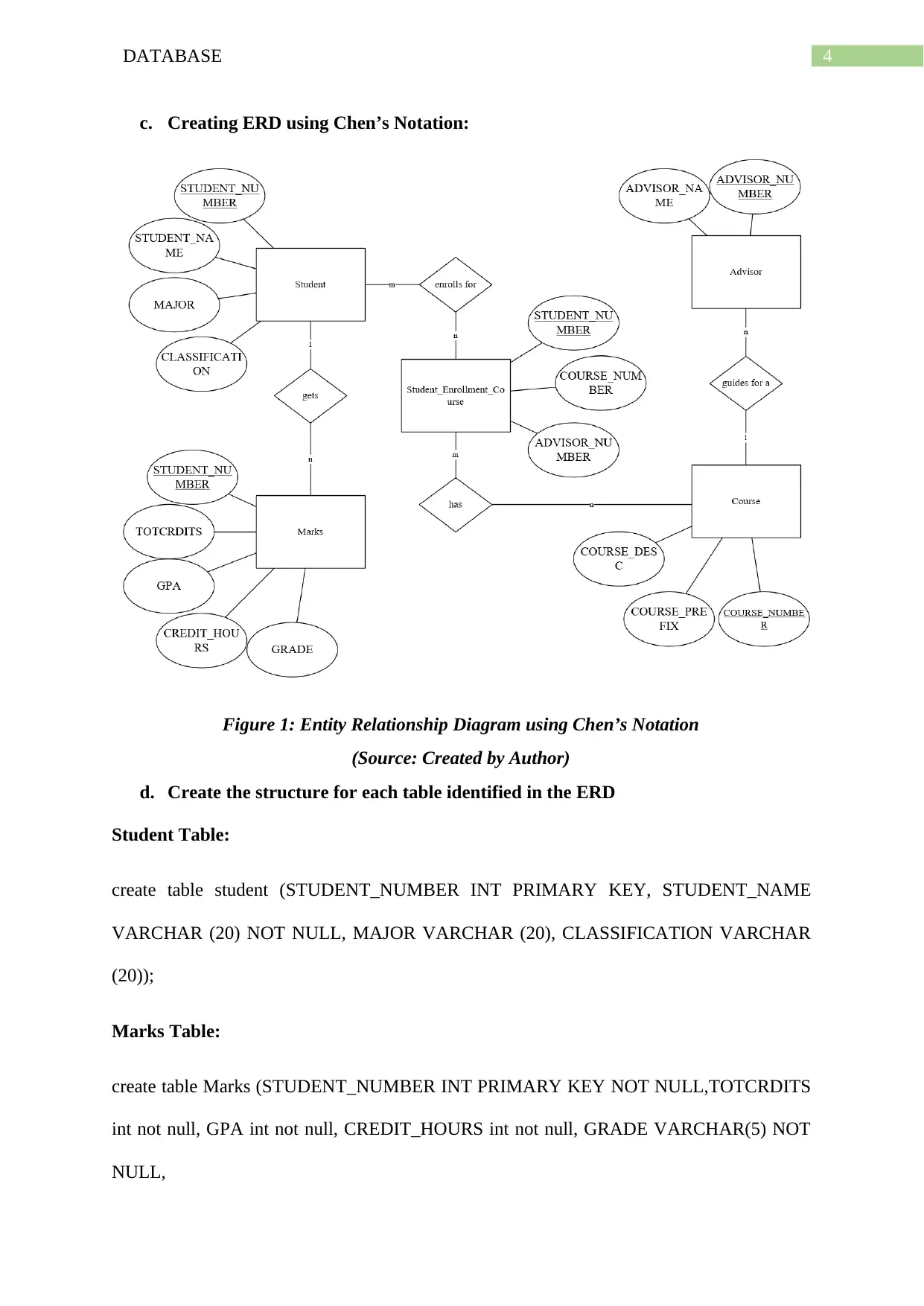
4DATABASE
c. Creating ERD using Chen’s Notation:
Figure 1: Entity Relationship Diagram using Chen’s Notation
(Source: Created by Author)
d. Create the structure for each table identified in the ERD
Student Table:
create table student (STUDENT_NUMBER INT PRIMARY KEY, STUDENT_NAME
VARCHAR (20) NOT NULL, MAJOR VARCHAR (20), CLASSIFICATION VARCHAR
(20));
Marks Table:
create table Marks (STUDENT_NUMBER INT PRIMARY KEY NOT NULL,TOTCRDITS
int not null, GPA int not null, CREDIT_HOURS int not null, GRADE VARCHAR(5) NOT
NULL,
c. Creating ERD using Chen’s Notation:
Figure 1: Entity Relationship Diagram using Chen’s Notation
(Source: Created by Author)
d. Create the structure for each table identified in the ERD
Student Table:
create table student (STUDENT_NUMBER INT PRIMARY KEY, STUDENT_NAME
VARCHAR (20) NOT NULL, MAJOR VARCHAR (20), CLASSIFICATION VARCHAR
(20));
Marks Table:
create table Marks (STUDENT_NUMBER INT PRIMARY KEY NOT NULL,TOTCRDITS
int not null, GPA int not null, CREDIT_HOURS int not null, GRADE VARCHAR(5) NOT
NULL,
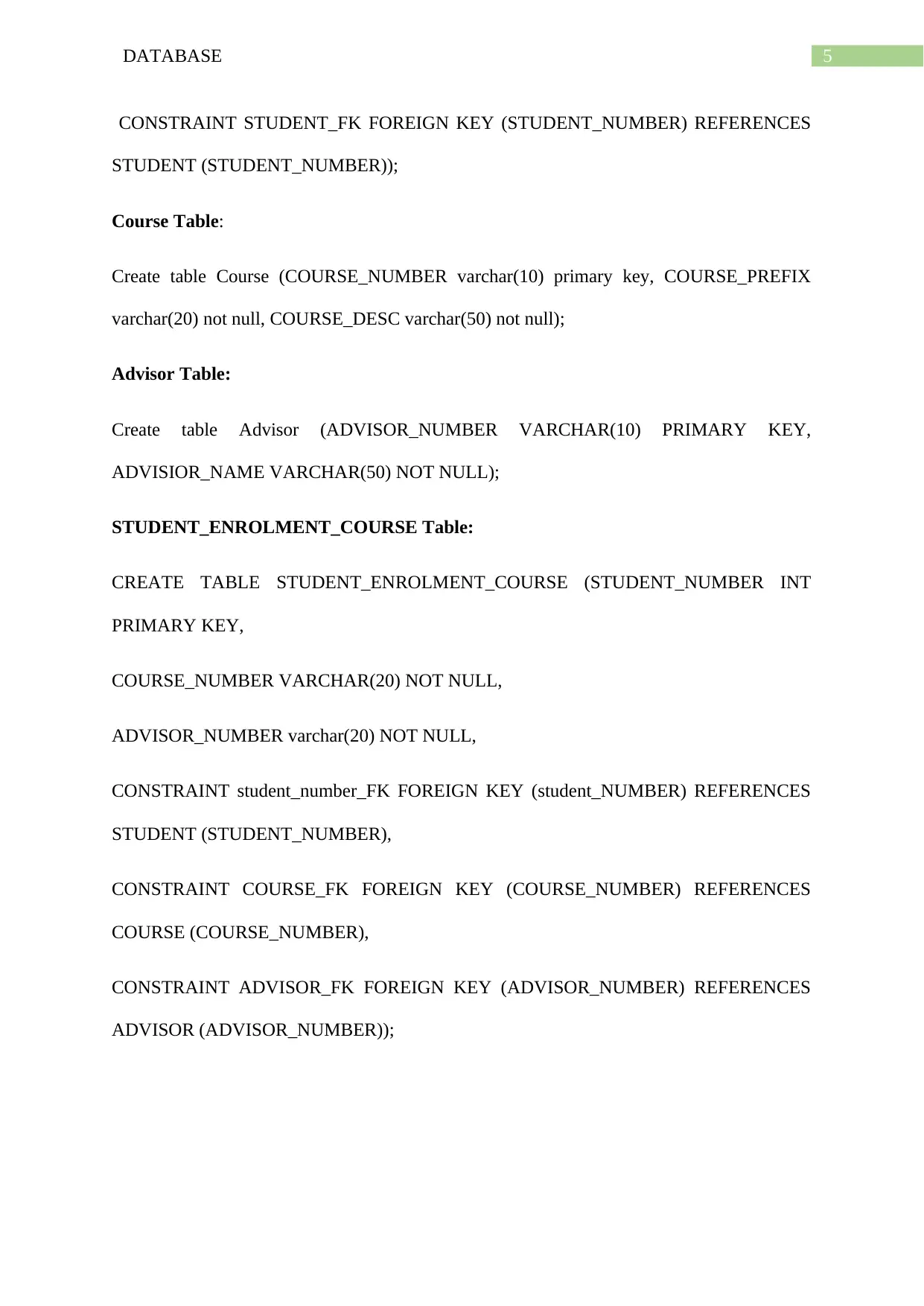
5DATABASE
CONSTRAINT STUDENT_FK FOREIGN KEY (STUDENT_NUMBER) REFERENCES
STUDENT (STUDENT_NUMBER));
Course Table:
Create table Course (COURSE_NUMBER varchar(10) primary key, COURSE_PREFIX
varchar(20) not null, COURSE_DESC varchar(50) not null);
Advisor Table:
Create table Advisor (ADVISOR_NUMBER VARCHAR(10) PRIMARY KEY,
ADVISIOR_NAME VARCHAR(50) NOT NULL);
STUDENT_ENROLMENT_COURSE Table:
CREATE TABLE STUDENT_ENROLMENT_COURSE (STUDENT_NUMBER INT
PRIMARY KEY,
COURSE_NUMBER VARCHAR(20) NOT NULL,
ADVISOR_NUMBER varchar(20) NOT NULL,
CONSTRAINT student_number_FK FOREIGN KEY (student_NUMBER) REFERENCES
STUDENT (STUDENT_NUMBER),
CONSTRAINT COURSE_FK FOREIGN KEY (COURSE_NUMBER) REFERENCES
COURSE (COURSE_NUMBER),
CONSTRAINT ADVISOR_FK FOREIGN KEY (ADVISOR_NUMBER) REFERENCES
ADVISOR (ADVISOR_NUMBER));
CONSTRAINT STUDENT_FK FOREIGN KEY (STUDENT_NUMBER) REFERENCES
STUDENT (STUDENT_NUMBER));
Course Table:
Create table Course (COURSE_NUMBER varchar(10) primary key, COURSE_PREFIX
varchar(20) not null, COURSE_DESC varchar(50) not null);
Advisor Table:
Create table Advisor (ADVISOR_NUMBER VARCHAR(10) PRIMARY KEY,
ADVISIOR_NAME VARCHAR(50) NOT NULL);
STUDENT_ENROLMENT_COURSE Table:
CREATE TABLE STUDENT_ENROLMENT_COURSE (STUDENT_NUMBER INT
PRIMARY KEY,
COURSE_NUMBER VARCHAR(20) NOT NULL,
ADVISOR_NUMBER varchar(20) NOT NULL,
CONSTRAINT student_number_FK FOREIGN KEY (student_NUMBER) REFERENCES
STUDENT (STUDENT_NUMBER),
CONSTRAINT COURSE_FK FOREIGN KEY (COURSE_NUMBER) REFERENCES
COURSE (COURSE_NUMBER),
CONSTRAINT ADVISOR_FK FOREIGN KEY (ADVISOR_NUMBER) REFERENCES
ADVISOR (ADVISOR_NUMBER));
⊘ This is a preview!⊘
Do you want full access?
Subscribe today to unlock all pages.

Trusted by 1+ million students worldwide
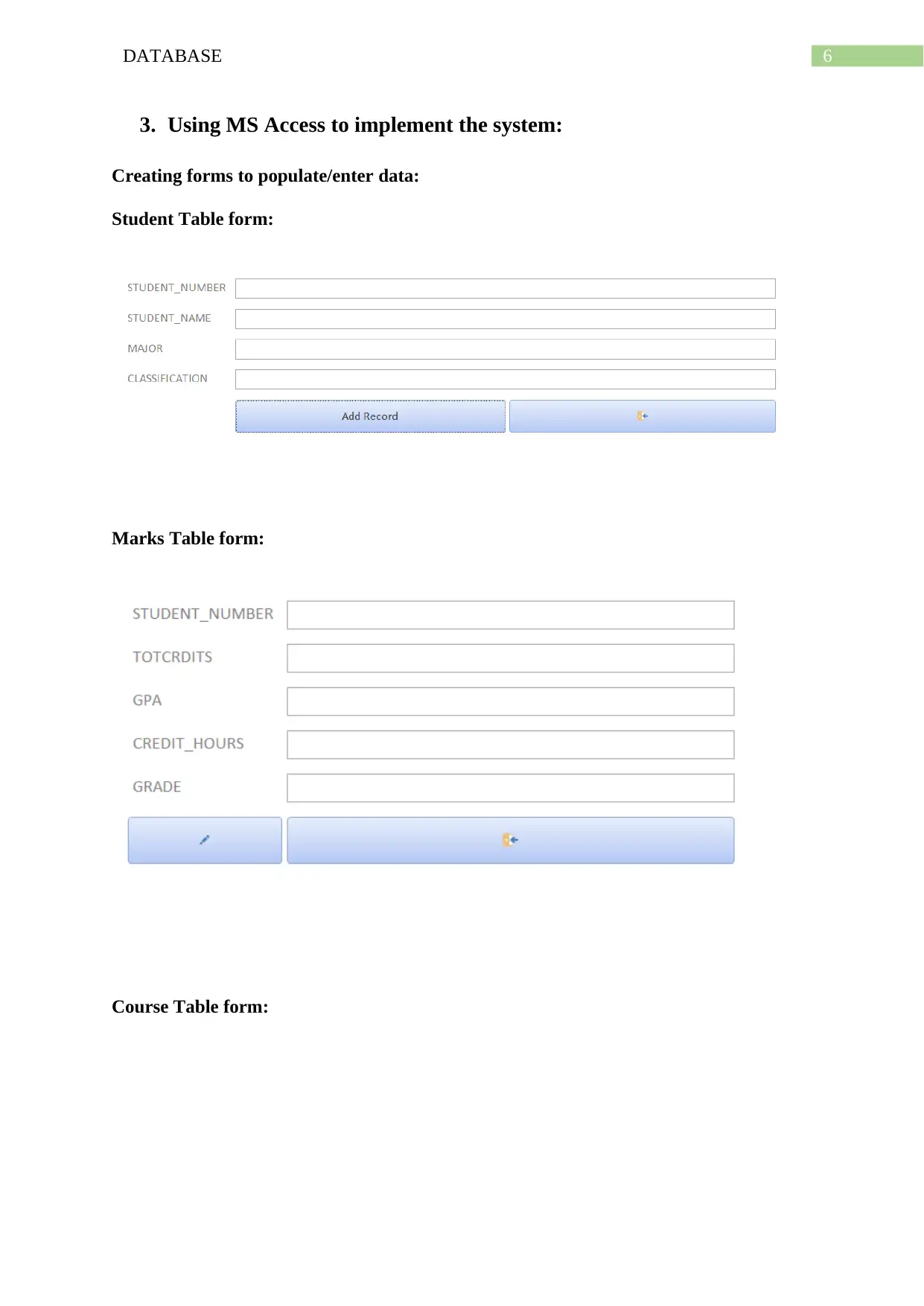
6DATABASE
3. Using MS Access to implement the system:
Creating forms to populate/enter data:
Student Table form:
Marks Table form:
Course Table form:
3. Using MS Access to implement the system:
Creating forms to populate/enter data:
Student Table form:
Marks Table form:
Course Table form:
Paraphrase This Document
Need a fresh take? Get an instant paraphrase of this document with our AI Paraphraser
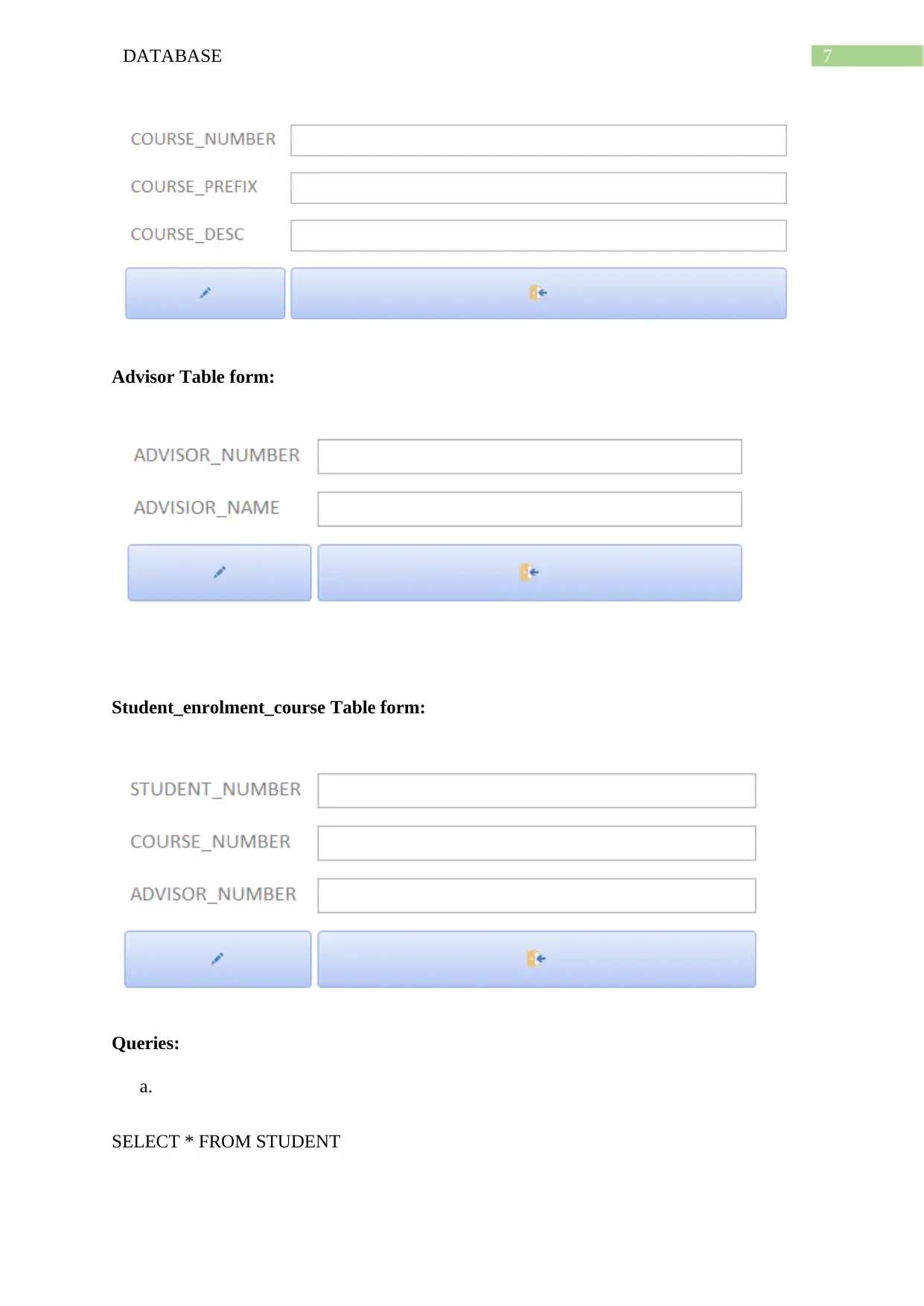
7DATABASE
Advisor Table form:
Student_enrolment_course Table form:
Queries:
a.
SELECT * FROM STUDENT
Advisor Table form:
Student_enrolment_course Table form:
Queries:
a.
SELECT * FROM STUDENT
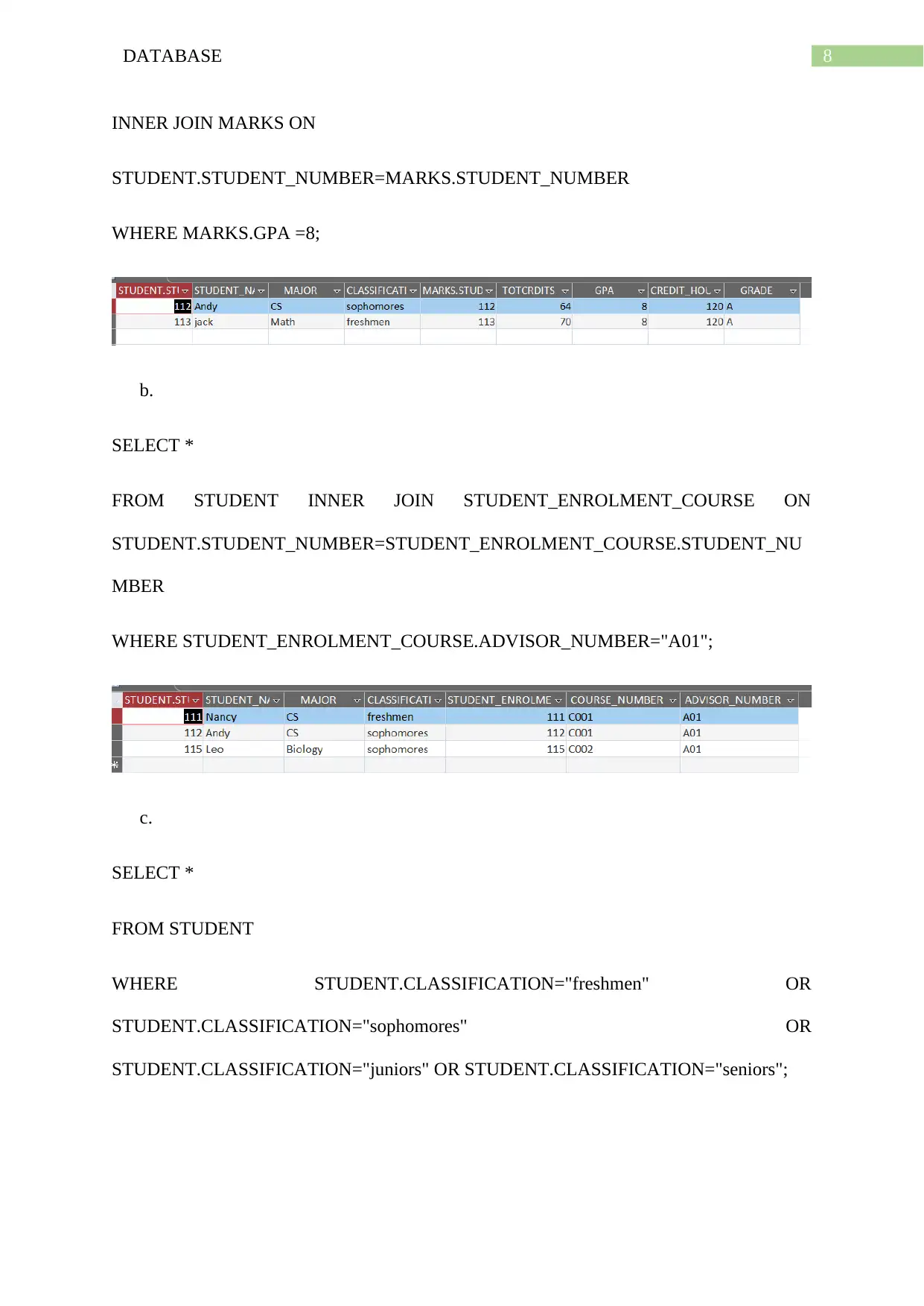
8DATABASE
INNER JOIN MARKS ON
STUDENT.STUDENT_NUMBER=MARKS.STUDENT_NUMBER
WHERE MARKS.GPA =8;
b.
SELECT *
FROM STUDENT INNER JOIN STUDENT_ENROLMENT_COURSE ON
STUDENT.STUDENT_NUMBER=STUDENT_ENROLMENT_COURSE.STUDENT_NU
MBER
WHERE STUDENT_ENROLMENT_COURSE.ADVISOR_NUMBER="A01";
c.
SELECT *
FROM STUDENT
WHERE STUDENT.CLASSIFICATION="freshmen" OR
STUDENT.CLASSIFICATION="sophomores" OR
STUDENT.CLASSIFICATION="juniors" OR STUDENT.CLASSIFICATION="seniors";
INNER JOIN MARKS ON
STUDENT.STUDENT_NUMBER=MARKS.STUDENT_NUMBER
WHERE MARKS.GPA =8;
b.
SELECT *
FROM STUDENT INNER JOIN STUDENT_ENROLMENT_COURSE ON
STUDENT.STUDENT_NUMBER=STUDENT_ENROLMENT_COURSE.STUDENT_NU
MBER
WHERE STUDENT_ENROLMENT_COURSE.ADVISOR_NUMBER="A01";
c.
SELECT *
FROM STUDENT
WHERE STUDENT.CLASSIFICATION="freshmen" OR
STUDENT.CLASSIFICATION="sophomores" OR
STUDENT.CLASSIFICATION="juniors" OR STUDENT.CLASSIFICATION="seniors";
⊘ This is a preview!⊘
Do you want full access?
Subscribe today to unlock all pages.

Trusted by 1+ million students worldwide
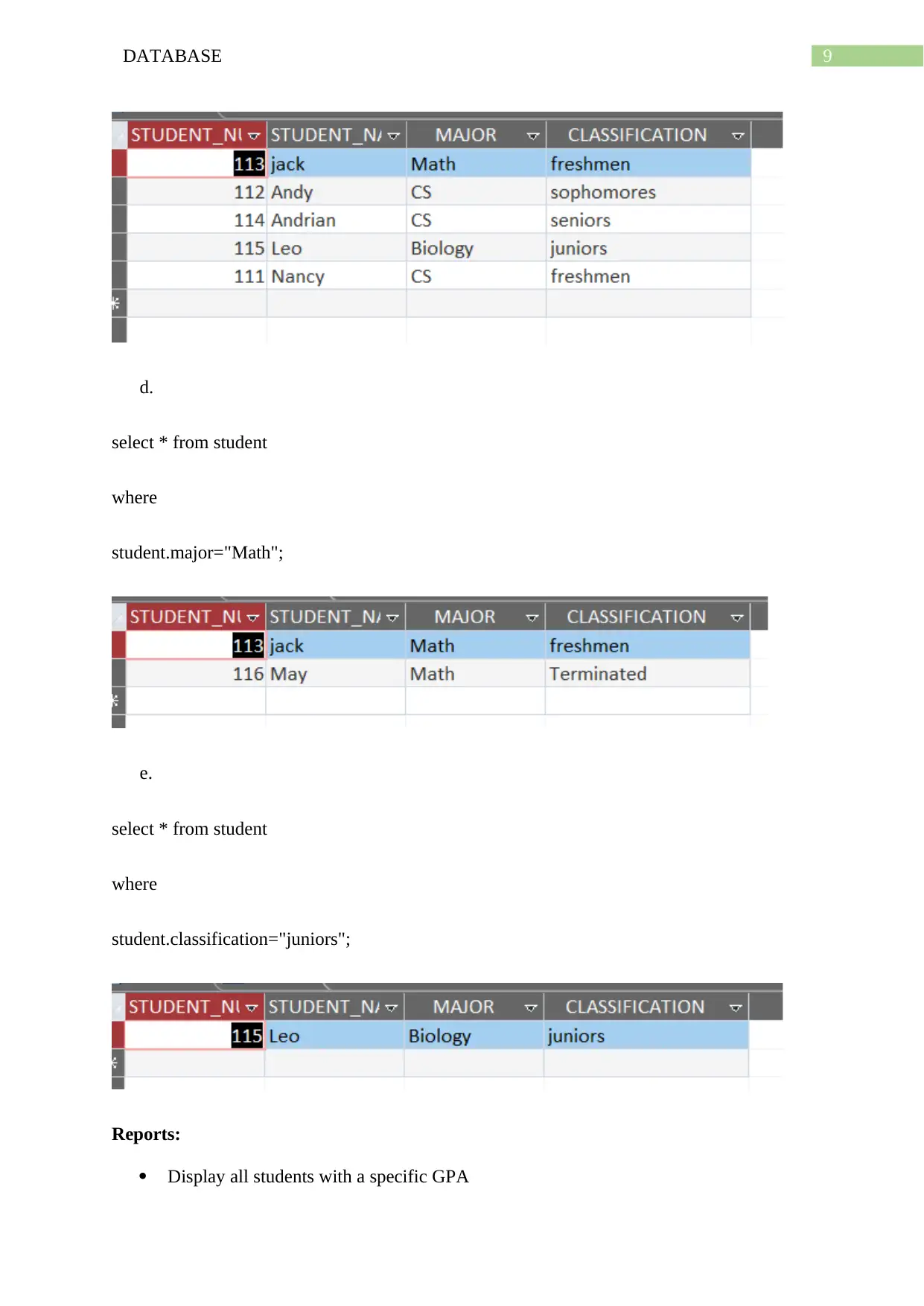
9DATABASE
d.
select * from student
where
student.major="Math";
e.
select * from student
where
student.classification="juniors";
Reports:
Display all students with a specific GPA
d.
select * from student
where
student.major="Math";
e.
select * from student
where
student.classification="juniors";
Reports:
Display all students with a specific GPA
Paraphrase This Document
Need a fresh take? Get an instant paraphrase of this document with our AI Paraphraser
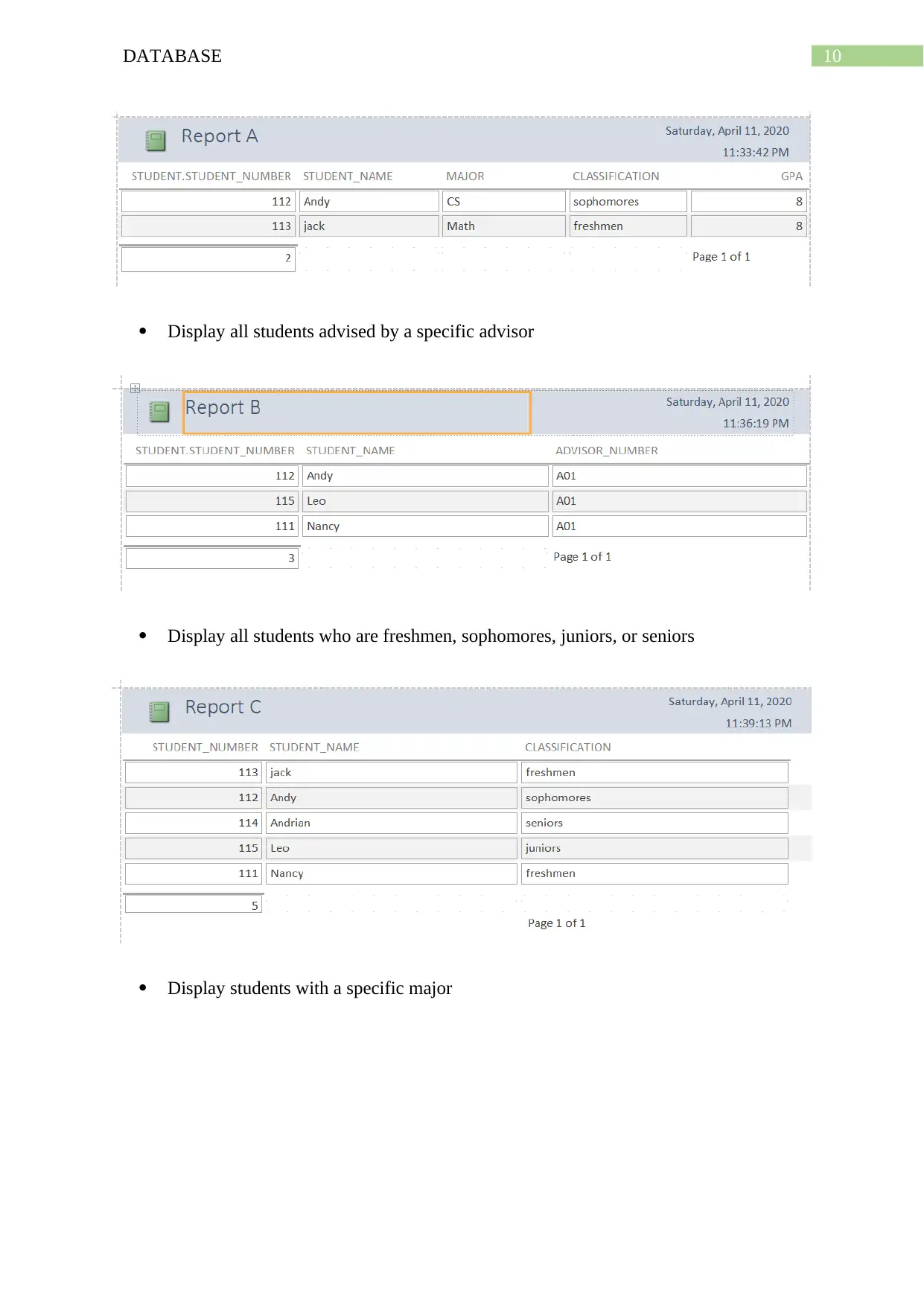
10DATABASE
Display all students advised by a specific advisor
Display all students who are freshmen, sophomores, juniors, or seniors
Display students with a specific major
Display all students advised by a specific advisor
Display all students who are freshmen, sophomores, juniors, or seniors
Display students with a specific major
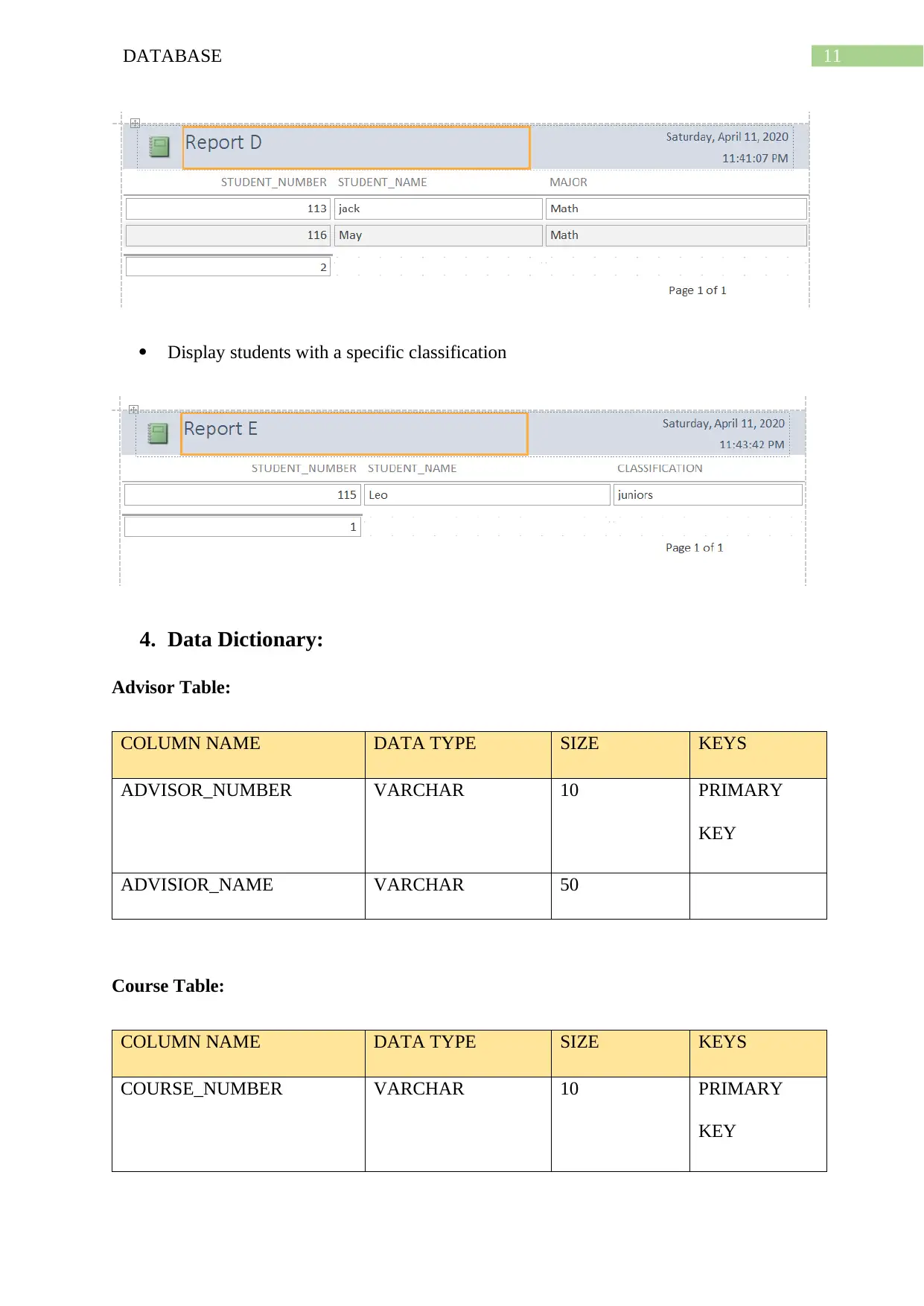
11DATABASE
Display students with a specific classification
4. Data Dictionary:
Advisor Table:
COLUMN NAME DATA TYPE SIZE KEYS
ADVISOR_NUMBER VARCHAR 10 PRIMARY
KEY
ADVISIOR_NAME VARCHAR 50
Course Table:
COLUMN NAME DATA TYPE SIZE KEYS
COURSE_NUMBER VARCHAR 10 PRIMARY
KEY
Display students with a specific classification
4. Data Dictionary:
Advisor Table:
COLUMN NAME DATA TYPE SIZE KEYS
ADVISOR_NUMBER VARCHAR 10 PRIMARY
KEY
ADVISIOR_NAME VARCHAR 50
Course Table:
COLUMN NAME DATA TYPE SIZE KEYS
COURSE_NUMBER VARCHAR 10 PRIMARY
KEY
⊘ This is a preview!⊘
Do you want full access?
Subscribe today to unlock all pages.

Trusted by 1+ million students worldwide
1 out of 15
Related Documents
Your All-in-One AI-Powered Toolkit for Academic Success.
+13062052269
info@desklib.com
Available 24*7 on WhatsApp / Email
![[object Object]](/_next/static/media/star-bottom.7253800d.svg)
Unlock your academic potential
Copyright © 2020–2025 A2Z Services. All Rights Reserved. Developed and managed by ZUCOL.




